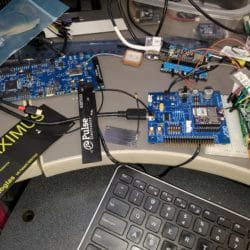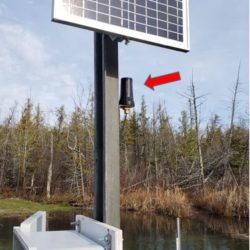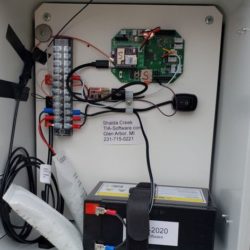Home › Forums › Mayfly Data Logger › Stronger cell antenna?
- This topic has 13 replies, 7 voices, and was last updated 2020-11-24 at 5:30 PM by
 Sara Damiano.
Sara Damiano.
-
AuthorPosts
-
-
2020-02-20 at 5:24 PM #13828Has anyone been able to improve cell signal with a different antenna on the XBee3? We’re using the Pulse W3907B0100. @lemon updatedHas anyone been able to improve cell signal with a different antenna on the XBee3? We’re using the Pulse W3907B0100. @lemon updated one of our stations in Michigan today with the latest firmware, and its data transmission is still intermittent. Just curious whether there’s an easy way to improve reception.
Thanks,
Matt -
2020-02-21 at 8:24 AM #13829Hi Matt
Any opportunity to extend the coaxial line?
I have thought about this issue, and planned to try one of these:
Hi MattAny opportunity to extend the coaxial line?
I have thought about this issue, and planned to try one of these:
https://www.data-alliance.net/u-fl-extension-cable-male-to-female-1-5-inch-2-in-3-in-4-in-6-in-7-in-8-in-10-inch/?gclid=Cj0KCQiAnL7yBRD3ARIsAJp_oLZgihbPsuyjcXW51G1_1HEFxT-kxrcJSm2XSu4Eh6WNAjJhtA9x8_waAonsEALw_wcBBut, Im not sure where I would mount the antenna, I am not fond of the idea of the worlds smallest coax running in/out of my enclosure.
What about the modem? Do you have a spare xbee3 around to swap out with the suspected ‘weak’ one?
Living vicariously through you with this issue, because I anticipate crossing this bridge.
-Evan
-
2020-02-21 at 10:34 AM #13830We’ve had great improvement with the Maximus FXUB66.We’ve had great improvement with the Maximus FXUB66.
https://www.digikey.com/product-detail/en/taoglas-limited/FXUB66.07.0150C/931-1202-ND/3724559
-
2020-02-21 at 10:40 AM #13831Great – thanks, Beth, we’ll check it out!
Hi Evan, Thanks for your response. I agree with your concerns about the tiny coax cable and the fragile uFL connector. Poking around yesterday,
Great – thanks, Beth, we’ll check it out!Hi Evan, Thanks for your response. I agree with your concerns about the tiny coax cable and the fragile uFL connector. Poking around yesterday, looking at additional options, I was considering adapting uFL to the larger SMA with something like this: https://www.adafruit.com/product/851 and then, if necessary, using an external SMA or RP-SMA antenna if that’s do-able. I’m pretty ignorant of what’s compatible with what at this point, so more reading to do!
Matt
-
2020-02-21 at 10:44 AM #13832What’s your enclosure? Is there a chance it’s blocking signal? There are probably apps for checking cell signal strength and direction.
The Maximus just connect straight to our Bee radios
What’s your enclosure? Is there a chance it’s blocking signal? There are probably apps for checking cell signal strength and direction.The Maximus just connect straight to our Bee radios and sits inside a plastic enclosure (Pelican and Polycase).
-
2020-02-21 at 10:56 AM #13833Our Mayfly, XBee3, and antenna are inside a Pelican case, so yeah, I was wondering whether that inhibits signal, but I’m really out of my technical depth on these antenna and signal questions. JOur Mayfly, XBee3, and antenna are inside a Pelican case, so yeah, I was wondering whether that inhibits signal, but I’m really out of my technical depth on these antenna and signal questions. Jake was able to get decent voice service on his Verizon phone at the site, and my understanding is that ModularSensors (or maybe it’s the XBee3’s firmware) will select between Verizon and AT&T based on signal strength, so I was hoping we’d see solid signal after I upgraded both.
-
2020-02-21 at 11:14 AM #13834Something to keep in mind is that our mobile phones have multiple radios and switch (mostly) seamlessly between different signals (3G, 4G, etc) but our XBee radios will only communicate on their desigSomething to keep in mind is that our mobile phones have multiple radios and switch (mostly) seamlessly between different signals (3G, 4G, etc) but our XBee radios will only communicate on their designated protocol(s). Looks like the XBee 3 is LTE-M and NB-IoT and I don’t know anything about the latter.
This means that what we see on our mobiles is not always equivalent to what the XBees can use. So we have to dig a little deeper to know if the signals/protocols that our phones are using are accessible for the radio connected to your data logger.
(Thus we have reached the edge of my experience on this because I was able to ride on older radios through last summer.)
-
2020-02-21 at 12:11 PM #13836All of the network selection/registration is done by the u-blox firmware. The Mayfly’s mcu tells the Digi mcu to tell the u-blox mcu to automatically select the network. ModularSensAll of the network selection/registration is done by the u-blox firmware. The Mayfly’s mcu tells the Digi mcu to tell the u-blox mcu to automatically select the network. ModularSensors doesn’t even both to ask which network gets selected. It could ask, but I never cared enough to implement it.
ModularSensors is also requesting automatic selection between LTE-M and NB IoT and the same telephone chain makes it happen. But, in reality, if you’re using a Hologram SIM, you will never use NB IoT. Hologram doesn’t currently support it in the USA. (https://community.hologram.io/t/nb-iot-usa/3434/7). All of their advertising makes it look like they do, but if it’s actually true for anywhere in the world, it’s not true for the USA.
I have the Tagolas Maximus that Beth linked, the same Pulse that you have, a PCB trace style antenna from a GPRS bee, and a unknown brand (came with a kit) stick antenna with an SMA/uFL adapter currently on my desk. Right this instant (literally right now) I’m seeing CSQ [scale of 0-30) of 12-16 with the Tagolas, 17-18 with the Pulse, 17 with the PCB antenna, and 18-19 with the stick antenna. (Yup, I just yanked the uFL off that many times just for you guys.) I personally prefer the little PCB trace antenna. I pretty sure the reason my big Tagolas antenna is so much more variable and lower than the others is that it’s big and thin and has gotten crumpled up sitting on my desk (hence my preference for the stiff PCB antenna). When using the flat patch style antennas, the orientation of the antenna and the cable can make a big difference – the data sheets for them have pictures of the exact amount of curve they’re supposed to have. Running any power cables the wrong way across the antenna can also kill you signal. (Remeber how one of the iPhones once had a warning about “don’t hold them this way” or you’ll get bad service?)
Attachments:
-
2020-02-21 at 1:25 PM #13838Following up on Beth’s comment on enclosure, the radio signal should get through the plastic case just fine, but the bigger issue is keeping distance between your antenna and any other metal, esFollowing up on Beth’s comment on enclosure, the radio signal should get through the plastic case just fine, but the bigger issue is keeping distance between your antenna and any other metal, especially wires and battery but also including your solar panel. I’m always careful to place my antenna in the top of the box, keeping the wires, battery and Mayfly lower down. I place my solar panel either below my box, or quite a bit above it, so that the antenna has no metal between it and the horizon. Beth and I first saw this issue when we mounted a station behind a guard rail. Lifting the top of the box 6 inches, so that it peaked over the guard rail, made all the difference.
Sara, thanks for your results from different antennas. I’m surprised that the PCB antenna from the GPRSBee worked better than the Taoglas Maximus FXUB66. When I swapped a bunch of those out last year on my GPRSBee stations, I found a huge benefit to using the Maximus. I’m also surprised that the GPRSBee antenna worked at all with LTE, because I thought GPRS & LTE were different frequencies. I had noticed that Sodaq started shipping their GPRSBees with different, larger antennas about a year or two ago, so I’m guessing their new antenna might have been selected to also accommodate LTE frequencies.
It’s true that the Taoglas Maximus FXUB66 is huge and sometimes hard to fit into a box. Based on your results, I’ll definitely start experimenting with other antennas.
-
2020-02-21 at 2:33 PM #13840@aufdenkampe, I’m sure that the Tagolas did better when it was new. You can’t really tell in my picture, but all of my bigger antennas are sort-of crumpled from being dragged back and fo@aufdenkampe, I’m sure that the Tagolas did better when it was new. You can’t really tell in my picture, but all of my bigger antennas are sort-of crumpled from being dragged back and forth in my backpack and getting shuffled around on my desk.
I would guess Sodaq’s decision to change antennas probably had more to do with suppliers and costs than anything else.
Most cellular antennas are very wide band or ultra wide band – they cover a lot of frequencies. And the major cell phone companies all use multiple LTE bands and frequencies. The last remaining GSM (2G) from T-Mobile’s is on band 2 at 1900 MHz: https://www.t-mobile.com/support/coverage/t-mobile-network, but globally GSM *could* be various bands anywhere from 350-1900 MHz. AT&T’s used to be on bands 2 (1900MHz) and 5 (850MHz) [https://www.frequencycheck.com/carriers/at-t-united-states] and I think those are the two most commonly used GSM bands globally [https://en.wikipedia.org/wiki/GSM_frequency_bands]. LTE can be on an even wider range of bands/frequencies – but if an antenna was already covering a wide enough range to get the main GSM bands, it can catch a lot of the LTE bands as well. T-Mobile’s main LTE band is the same band 2 that it uses for GSM. Verizon and AT&T’s “favorite” bands are 12 & 13, which are both 700MHz [https://www.whistleout.com/CellPhones/Guides/cell-phone-networks-and-frequencies-explained] – but they both also use bands 2 and 5 for LTE. Even if you had an antenna focused at only the 1900 GSM band, which I think is unlikely, it might do fine for LTE. I think 2G disappeared so they could use the same band space for LTE.
-
2020-02-21 at 5:50 PM #13842A few years ago, we used to put SMA jacks with bulkhead fittings through the Pelican case and use an external weatherproof antenna outside the case. But the signal loss caused by the extra coax andA few years ago, we used to put SMA jacks with bulkhead fittings through the Pelican case and use an external weatherproof antenna outside the case. But the signal loss caused by the extra coax and the bulkhead fitting caused more to lower the overall signal than just using a small antenna inside the Pelican case. So unless we’re connecting a high-gain or directional antenna to a 900mhz radio module for our on-site radio network, I found it unnecessary to put a cell phone antenna outside the case. And as Anthony mentioned above, the antenna orientation and proximity to metal or other large objects has more of an influence on your signal strength than the style of antenna.
-
2020-02-21 at 7:03 PM #13843Wow – thanks, all, for the great information!
Because our problem site is relatively inconvenient to access, I think on our (@jlemontu-org ‘s) next visit, he’ll come armed with a nu
Wow – thanks, all, for the great information!Because our problem site is relatively inconvenient to access, I think on our (@jlemontu-org ‘s) next visit, he’ll come armed with a number of options. We’ll pick up a Taoglas antenna, as well as bring along a spare Pulse antenna, in case the existing one is compromised. And we can experiment with different antenna positions relative to the other conductive components in the enclosure. Perhaps it makes a difference which plane the antenna is oriented in as well.
Really appreciate you all sharing your wisdom! (and I love the photo of your workbench, Sara!)
Best,
Matt -
2020-11-23 at 9:41 AM #14858We just had an experience with antennae that might interest others. We have a dozen sensor stations in the field measuring water level of lakes in north western Michigan. Each station has an SDI-1We just had an experience with antennae that might interest others. We have a dozen sensor stations in the field measuring water level of lakes in north western Michigan. Each station has an SDI-12 water level sensor connected to a Mayfly with a Digi XBee3 Cellular LTE-M/NB-IoT modem using a $3.00 antenna from Adafruit (https://www.adafruit.com/product/antenna) in a fiberglass enclosure. The system wakes up every 15 minutes to record water levels. At the top of each hour it connects to the tower and sends the collected measurements to our website; Lake-Man.com.
The last station that we installed was in a remote area with very poor LTE coverage. Our modem took minutes to connect and sometimes failed for several hours. Mobile phones have trouble connecting there. Moving the antenna around, shifting the battery position and trying different modems and options had little effect. After reading various posts on EnviroDIY, we decided to try other antennae mentioned there.
For us, the Maximus antenna and other internal-to-enclosure antennae performed similarly – that is to say poorly at this site. As a last resort, we installed a $16 external antenna from Amazon https://www.amazon.com/antenna using an SMB to UFL adapter cable.
The result was a major success – the modem connects within 10 seconds and hasn’t missed a transmission since we installed it. The 10 foot cable did not overly attenuate the signal in our experience.
Attachments:
-
2020-11-24 at 5:30 PM #14861
@ckillen – That is awesome, and not too spendy either.
-
-
AuthorPosts
- You must be logged in to reply to this topic.

 Welcome to EnviroDIY, a community for do-it-yourself environmental science and monitoring. EnviroDIY is part of
Welcome to EnviroDIY, a community for do-it-yourself environmental science and monitoring. EnviroDIY is part of 

